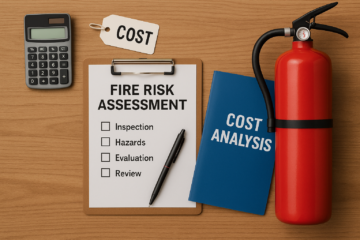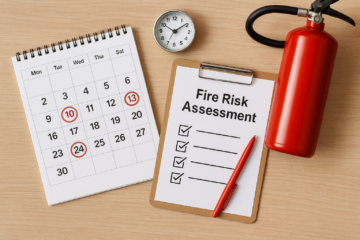Picture a quiet Tuesday night in Croydon. Jane, on the third floor, smells burning toast from the flat below. She opens her door, peers into the corridor, and breathes easy: the smoke’s trapped inside the neighbour’s flat and the lobby is clear. Why? Because the block’s fire doors shut tight, the alarms were tested last week, and the building’s “Responsible Person” knew exactly what had to be fixed after the last residential block fire risk assessment.
This guide breaks down the same rules that kept Jane safe—without the jargon. We’ll look at who holds the legal keys, which parts of the building need what checks, how to spot a lazy fire door, and the answers leaseholders ask every month.
Understanding the importance of a residential block fire risk assessment is crucial for ensuring safety in multi-family dwellings. Let’s dive in to the details.
Understanding the Residential Block Fire Risk Assessment
1 Who is the ‘Responsible Person’?
(Spoiler: it’s not always the caretaker.)
Under the Fire Safety Order (FSO) and the new Building Safety Act, every block of flats must have someone designated as the fire safety officer. The law refers to this person as the Responsible Person (RP). Think of the RP as the team captain: they plan the drills, pick the players (contractors), and keep the score (paperwork).
Who can it be?
- A managing agent (common in Bromley).
- A resident-led Right-to-Manage company.
- The freeholder’s surveyor.
- A Housing Association’s estates officer.
If there’s more than one party, the law says they must co-operate. So a landlord who owns the shop below your flats might share duties for the alarm panel in the basement hall.
Day-to-day RP tasks
- Book a professional fire-risk assessment (FRA) and review it yearly.
- Record actions—like replacing worn seals on doors.
- Keep log books: alarm tests, emergency-light checks, extinguisher services.
- Tell residents when—and why—work is happening. A Friday email beats mystery drilling at 7 a.m.
Winter tip: Book FRA reviews before Christmas. Decor lovers add fairy lights in lobbies—assessors can spot overloaded sockets early.
2 Communal vs Demised Areas—what’s mine, what’s yours?
Blocks of flats hold two worlds:
| Area | Fancy word | Who keeps it safe? |
|---|---|---|
| Stairwells, lobbies, bin stores, plant rooms | Communal | Responsible Person |
| Inside each flat’s front door | Demised | Resident or leaseholder |
Why the split matters
Sprinklers, alarms, and doors in communal routes must follow BS 5839 and BS 8214. The RP arranges testing.
Furniture, candles, e-scooters, chip-pans inside a flat are down to the occupant. Yet their risks can leak out. That’s why modern FRAs now peek at front-door condition and balcony storage.
Common grey zones
- Meter cupboards in corridors—communal.
- Balconies—often demised, but BBQs can break block rules.
- Loft spaces above top-floor flats—shared; smoke detection is a must.
Summer note: People charge e-bikes on balconies once the sun shines. Remind residents those lithium packs can flare—keep them indoors on a non-combustible surface and away from exits.
3 Fire-Door Maintenance—your silent bodyguard
A front door to each flat isn’t just timber and paint. It’s a 30-minute shield. A warped frame or missing seal turns that shield into soggy cardboard.
Five-point door check you can do on a coffee break
- Self-closer test
Open the door halfway. Let go. Does it shut and latch without a shove? If not, adjust or replace the closer. - Intumescent strips & smoke seals
Look along the edge. Strips should be unbroken, firmly fixed, and springy. Gaps or paint blobs mean new seals. - Gaps around the door
Slip a £1 coin around the frame. If it slides through more than 3 mm on top or sides, a joiner needs to tweak the hinges. - Letterbox
It must be fire-rated. Springs should snap shut, leaving no crack for smoke. - Glazing
Any vision panel must have fire-resistant glass with an etched BS symbol. Plain glass will fail in minutes.
Communal fire doors on cupboards and lobbies deserve the same love. Many blocks in Manchester’s Northern Quarter failed audits last year because cleaners wedged doors for trolley runs. Simple fix? Fit dorgard devices that release on alarm.
4 Leaseholder FAQs—straight answers nobody gives in the handbook
The assessor wants to look inside my flat. Do I have to let them in?
Legally, the FRA covers common areas, but the Building Safety Act pushes RPs to inspect front doors. A quick look at hinges and seals usually takes two minutes. You can be present, and no photos of private items are kept.
My front door opens onto a balcony walkway. Does it still need to be fire-rated?
Yes. Even outdoor decks can fill with smoke. A fire-door slows spread and gives you time to reach the stairs.
Who pays for new door closers?
If your lease says the landlord maintains structure and common parts, they’ll fit communal door gear. Flat front doors? Often down to the leaseholder—check the wording. Many blocks in Leeds city centre chip in through the service charge.
The block has sprinklers in corridors. Do we still need smoke alarms inside flats?
Absolutely. Sprinklers slow growth but won’t wake you at 2 a.m. Fit linked detectors in the hall and living room.
Can I keep a bike in the stairwell?
Sorry—no. Anything that narrows the exit route breaks the FSO. Many London councils give free bike hangars on the street; apply there instead.
Putting it all together—your three-step resident plan
- Know the captain. Find out who your RP is. Save their email.
- Check your shield. Inspect your front door this weekend using the five-point list.
- Speak up. Spot cracked seals, wedged lobby doors, or bikes in corridors? Tell the RP. A quick photo helps.
Communal action calendar
| Month | Job | Why then? |
|---|---|---|
| January | Test emergency lights | Dark mornings show failures fast |
| April | FRA review | Before summer balcony BBQs |
| July | Service dry riser | Warm weather helps drain tests |
| October | Fire-door survey | Catch swelling or warp after humid summer |
| December | Email fairy-light safety note | Festive cables overload sockets |
Story close-out
Remember Jane in Croydon? Her safety owed nothing to luck. It was the chain of small, boring tasks: a manager who booked the FRA, a joiner who swapped worn seals, neighbours who kept corridors clear. Fire safety isn’t heroics; it’s housekeeping.
Make it easy. Put reminders in your phone. Tape the five-point check behind the cupboard door. Chat to the RP at the next AGM. Tiny habits build a wall between you and disaster.
Want deeper guidance?
Check out All Well’s Complete Fire-Safety Guide— Or call 0203 920 9617 for a friendly chat and quote. Safe homes start with informed neighbours.


